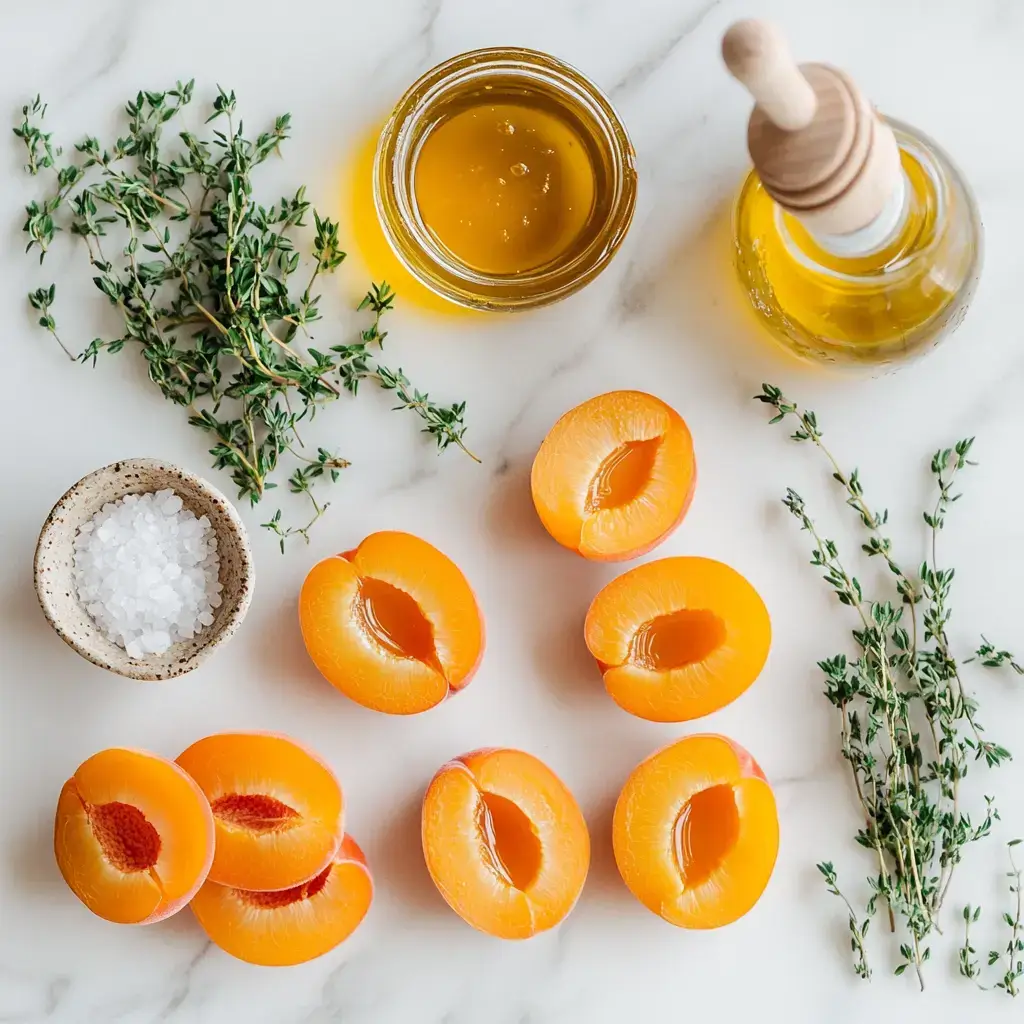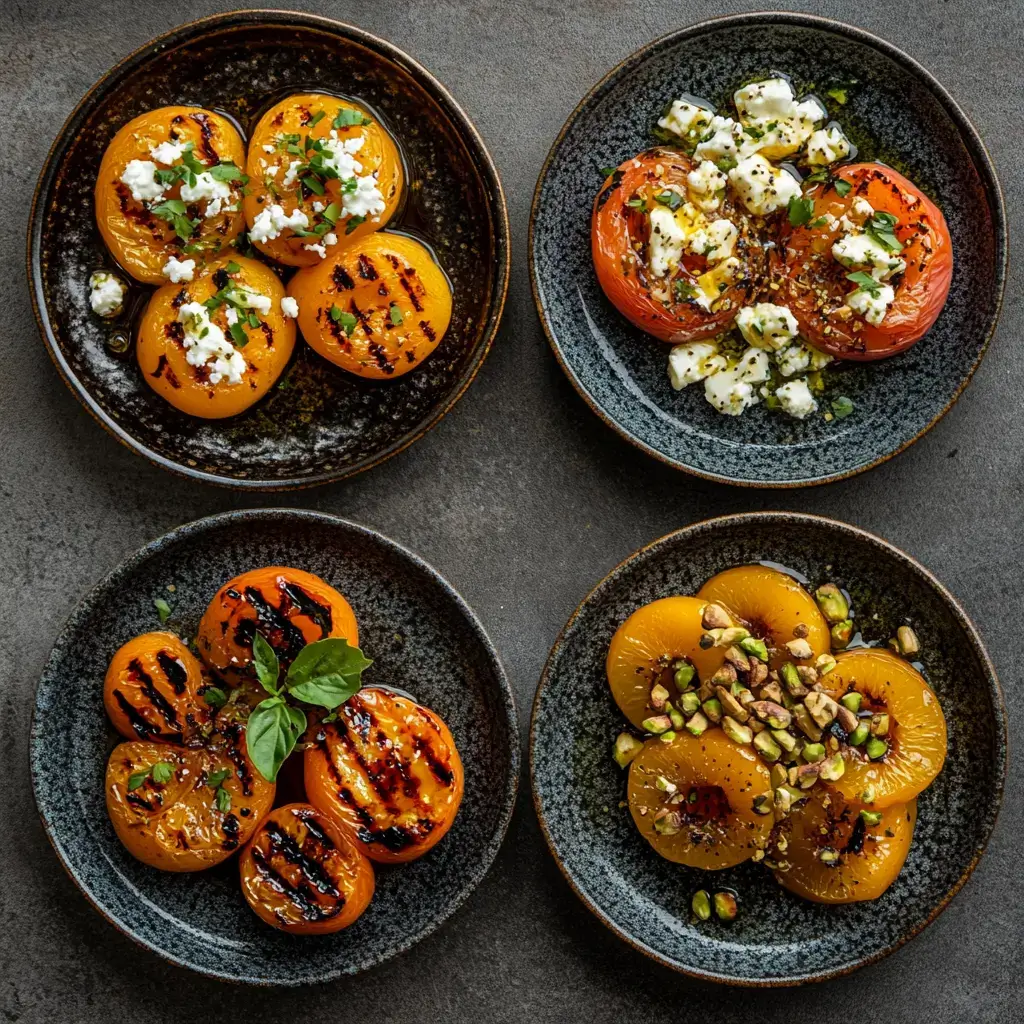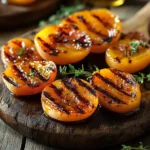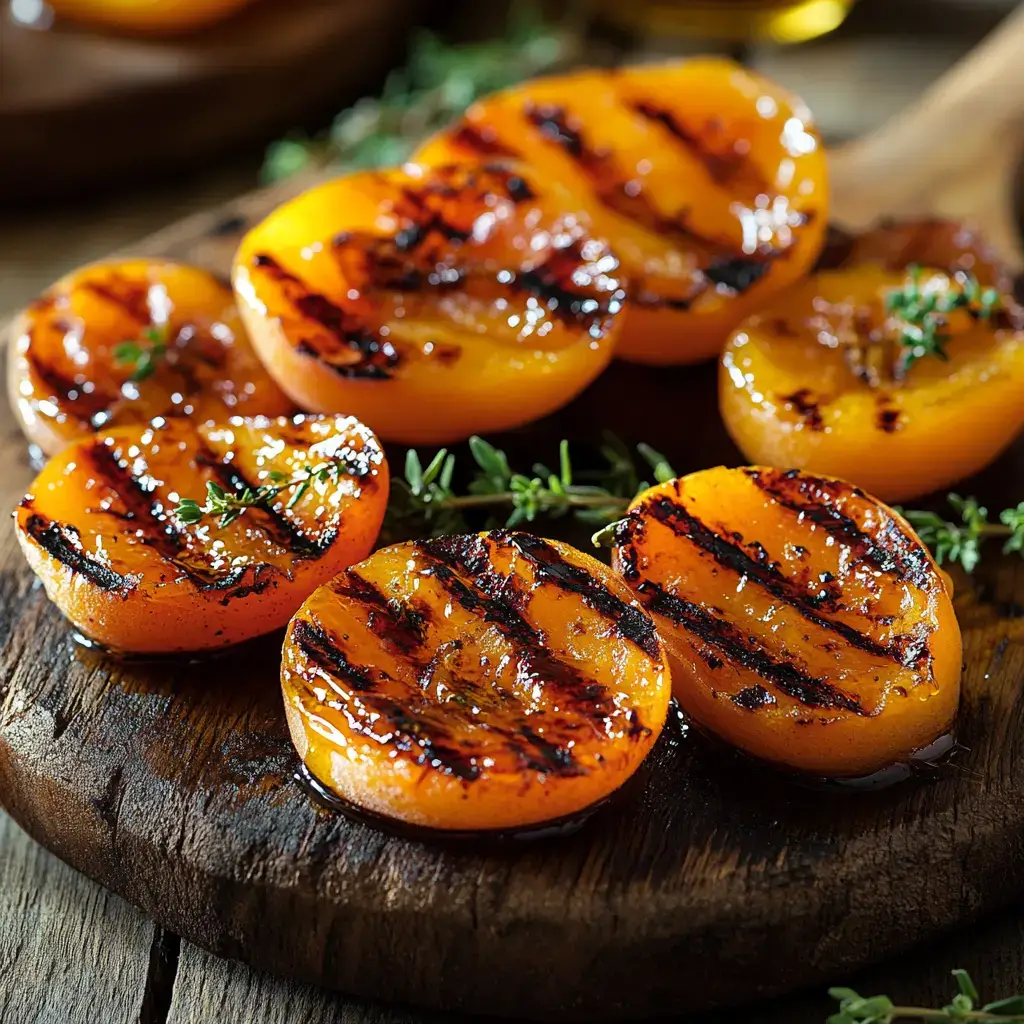Grilled apricots might just be the game-changing dessert you never knew you needed. Tired of the same old fruit salads and store-bought desserts that leave your guests underwhelmed? I’m Michael, a passionate culinary artist who thrives on reimagining traditional dishes, and I’m here to share a recipe that will have your dinner guests talking long after the last bite.
This grilled apricots with honey and thyme recipe promises to deliver a sophisticated yet simple dessert that transforms humble stone fruit into a caramelized, aromatic masterpiece. The natural sugars in the apricots caramelize beautifully on the grill, while the honey and thyme create a flavor profile that’s both familiar and surprisingly elegant.
As someone who’s spent years experimenting with diverse ingredients and combining them in ways that spark curiosity, I’ve discovered that grilling fruit is one of the most underutilized techniques in home cooking. Through my work at FoodyDish.com, I’ve seen how this simple method can turn everyday meals into extraordinary experiences.
In this guide, we’ll cover everything from selecting the perfect apricots to mastering the grilling technique, plus creative variations that cater to different dietary needs and flavor preferences. Whether you’re hosting a summer barbecue or looking for a quick weeknight dessert, this recipe will become your new go-to.
Why This Grilled Apricots Recipe Works
This grilled apricots recipe succeeds where many fruit desserts fail because it perfectly balances simplicity with sophistication. Here’s what makes it exceptional:
• Uses affordable, easy-to-find seasonal fruit – Apricots are typically abundant and budget-friendly during summer months, making this an accessible luxury dessert
• Ready in just 10 minutes for maximum flavor impact The high heat of the grill quickly caramelizes the fruit’s natural sugars while maintaining a tender-firm texture
• Perfect for both casual weeknight dinners and elegant entertaining – This versatile dessert scales beautifully from intimate dinners to large gatherings
• Naturally accommodates various dietary preferences – The base recipe is naturally gluten-free, dairy-free, and can easily be made vegan by substituting maple syrup for honey
The magic happens when the grill’s direct heat creates those beautiful caramelized edges while the fruit’s interior remains juicy and tender. The honey amplifies the apricots’ natural sweetness, while the thyme adds an unexpected herbal note that elevates the entire dish beyond typical grilled fruit.
Choosing the Right Apricots for Grilled Apricots
Success with grilled apricots starts with selecting the perfect fruit. The right apricots can make the difference between a memorable dessert and a disappointing one.
Best Apricots for This Recipe
The ideal apricots for grilling are firm-but-ripe specimens that can withstand the heat without falling apart. Look for fruit that yields slightly to gentle pressure but isn’t soft or mushy. The skin should have a vibrant orange color with a slight blush, and the fruit should feel heavy for its size, indicating good juice content.
Avoid apricots that are rock-hard (they won’t develop proper sweetness) or overly soft (they’ll turn to mush on the grill). The perfect grilling apricot should have a slight give when you press it gently, similar to a ripe peach.
Buying Tips
When shopping for apricots, visit your local farmer’s market if possible the fruit is often picked at peak ripeness rather than being harvested early for shipping. Look for apricots with smooth, unblemished skin and avoid any with dark spots, wrinkles, or soft patches.
The aroma test is crucial: ripe apricots should smell sweet and fragrant at the stem end. If there’s no scent, the fruit likely won’t have much flavor. Don’t be afraid to ask your produce manager when the apricots arrived fresher is always better for grilling.
Substitutions
While apricots are the star of this recipe, you can easily adapt this grilled apricots technique to other stone fruits. Peaches and nectarines work beautifully with the same cooking method and timing. Plums require an extra minute or two on the grill due to their denser flesh, while pears can be substituted for a fall variation, though they’ll need slightly longer cooking time.
Ingredients & Prep for Perfect Grilled Apricots
Creating exceptional grilled apricots starts with proper preparation and understanding how each ingredient contributes to the final result.
Complete Ingredients List
For Perfect Grilled Apricots (Serves 4):
- 8 ripe apricots (halved and pitted)
- 2 tbsp olive oil or melted butter
- 2 tbsp h
- oney (or maple syrup for vegan option)
- 1 tsp fresh thyme leaves (optional)
- A pinch of sea salt
- Vanilla ice cream, whipped cream, or Greek yogurt (for serving)
Optional Gourmet Toppings:
- Crushed pistachios
- Toasted almonds
- Balsamic glaze
- Crumbled goat cheese (for savory variation)

Fruit Prep Essentials
The key to perfectly grilled apricots lies in the preparation. Start by washing your apricots gently under cool water and patting them completely dry any excess moisture will cause splattering on the grill and prevent proper caramelization.
Cut each apricot in half along the natural seam, then twist the halves apart and remove the pit. This technique, called “freestone” cutting, works best with ripe apricots. If the pit sticks, use a small spoon to gently scoop it out, being careful not to damage the fruit.
Brush the cut surfaces immediately with olive oil or melted butter to prevent sticking and promote even browning. This step is crucial for achieving those beautiful grill marks that make the dish so visually appealing.
Honey & Seasoning Blend
The honey serves multiple purposes in this grilled apricots recipe – it adds sweetness, helps with caramelization, and creates a beautiful glaze. Choose a high-quality honey with distinct flavor notes; wildflower or orange blossom honey complement apricots particularly well.
Fresh thyme leaves provide an aromatic contrast to the fruit’s sweetness. Strip the leaves from the stems just before using to preserve their volatile oils. If you don’t have fresh thyme, substitute with fresh rosemary or even a pinch of dried herbs, though fresh is always preferred for optimal flavor.
The pinch of sea salt might seem unusual in a fruit dessert, but it’s essential for enhancing all the other flavors and creating complexity in each bite.
Pantry Staples
Beyond the main ingredients, keep these essentials on hand for grilled apricots success: high-quality olive oil (for brushing), pure maple syrup (as a honey alternative), and vanilla extract (for serving accompaniments). These simple ingredients ensure you can create this dessert whenever fresh apricots are available.
Step-by-Step Cooking Instructions for Grilled Apricots
Mastering the technique for grilled apricots requires attention to timing and temperature. Follow these detailed steps for consistent, restaurant-quality results.
Pre-Cooking Prep for Grilled Apricots
Before firing up the grill, ensure your grilled apricots are properly prepared for cooking. Remove the apricots from the refrigerator 15-20 minutes before grilling to bring them closer to room temperature – this prevents shocking the fruit with extreme temperature changes.
Clean your grill grates thoroughly and oil them lightly to prevent sticking. Preheat your grill to medium-high heat, around 400-450°F. If using a gas grill, preheat with the lid closed for 10-15 minutes. For charcoal grills, arrange coals for medium-high direct heat.
Have all your finishing ingredients ready: honey in a squeeze bottle or small bowl with a spoon, fresh thyme leaves picked from stems, and sea salt measured out. This preparation ensures smooth execution once the apricots hit the grill.
Cooking Method for Grilled Apricots
Place the prepared grilled apricots cut-side down on the hottest part of the grill. The initial searing is crucial for developing those distinctive grill marks and beginning the caramelization process. Cook for 2-3 minutes without moving them – resist the urge to peek or adjust their position.
You’ll know the apricots are ready to flip when you can easily lift them with tongs and see defined grill marks on the cut surface. The fruit should feel slightly softened but still hold its shape. Flip carefully and grill the skin side for 1-2 additional minutes.
The total cooking time for grilled apricots should be 3-5 minutes, depending on the fruit’s ripeness and your grill’s heat intensity. Overcooked apricots become mushy and lose their appealing texture contrast.
Doneness Check for Grilled Apricots
Perfect grilled apricots should yield slightly to gentle pressure while maintaining their shape. The cut surface should display clear grill marks with some caramelization around the edges, and the skin should show slight charring without being burnt.
Unlike meat cookery, there’s no specific internal temperature for grilled fruit. Instead, rely on visual and tactile cues: the apricots should look glossy and caramelized, feel tender but not mushy, and release their aromatic oils when properly cooked.
If the apricots seem too firm after the initial cooking time, move them to a cooler part of the grill and continue cooking for another minute or two, checking frequently to prevent overcooking.
Resting and Finishing Grilled Apricots
Transfer your grilled apricots immediately to a serving platter to stop the cooking process. Working quickly, drizzle with honey while the fruit is still warm – the heat will help the honey penetrate slightly and create a beautiful glaze.
Sprinkle with fresh thyme leaves and a light pinch of sea salt while the apricots are hot. This timing allows the aromatics to bloom and meld with the fruit’s natural juices. Let the grilled apricots rest for 2-3 minutes before serving to allow the flavors to integrate.
Pro Tips for Perfect Grilled Apricots
Elevating your grilled apricots from good to exceptional requires mastering these professional techniques I’ve developed through years of experimentation.
Avoiding Mushy or Burnt Grilled Apricots
The biggest mistake home cooks make with grilled apricots is using fruit that’s too ripe or applying too much heat. Overly soft apricots will collapse on the grill, while excessive heat creates bitter char flavors that overpower the fruit’s delicate sweetness.
Control your grill’s temperature zones by creating areas of different heat intensity. Keep the hottest zone for initial searing and have a medium-heat area for finishing if needed. This technique prevents burning while ensuring proper caramelization.
Never overcrowd the grill when making grilled apricots. Give each piece adequate space for even heat circulation and easy flipping. Crowded fruit steams rather than grills, resulting in soggy, unappetizing texture.
Essential Tool Recommendations for Grilled Apricots
Success with grilled apricots depends on having the right equipment. Invest in long-handled, thin-bladed tongs that won’t damage delicate fruit when flipping. A pastry brush or silicone basting brush ensures even oil application without tearing the fruit’s surface.
Consider using a grill basket for smaller or more delicate apricot pieces, though direct grilling produces superior caramelization and grill marks. A spray bottle filled with water helps control flare-ups without disrupting the cooking process.
For consistent results, use an instant-read thermometer to monitor your grill’s temperature. Grilled apricots cook best at 400-450°F, and maintaining this temperature ensures even cooking and proper caramelization.
Storage & Reheating Grilled Apricots
While grilled apricots are best served immediately, leftovers can be stored in the refrigerator for up to three days. Place them in a covered container with any accumulated juices – these concentrated flavors are perfect for drizzling over ice cream or yogurt.
To reheat grilled apricots, place them in a 350°F oven for 3-4 minutes until warmed through, or give them a quick 30-second blast in the microwave. Avoid re-grilling, as this will overcook the fruit and create unpleasant textures.
Frozen grilled apricots maintain their quality for up to three months when stored in freezer-safe containers. Thaw overnight in the refrigerator before reheating, and expect some texture changes due to the freezing process.
Flavor Variations for Grilled Apricots
One of the joys of working with grilled apricots is their versatility as a canvas for different flavor profiles. Here are my favorite variations that cater to various tastes and dietary needs.
Spicy Twist on Grilled Apricots
Transform your grilled apricots into an exciting sweet-heat dessert by adding a pinch of cayenne pepper or chipotle powder to the honey before drizzling. The smokiness of chipotle particularly complements the fruit’s natural sweetness and the grill’s char flavors.
For a more complex spicy variation, create a honey-harissa glaze by mixing one teaspoon of harissa paste with three tablespoons of honey. This North African-inspired twist adds depth and warmth that pairs beautifully with vanilla ice cream or Greek yogurt.
Keto and Paleo Grilled Apricots
Adapting grilled apricots for keto and paleo diets is simple and delicious. Replace the honey with sugar-free maple syrup or a keto-friendly sweetener like monk fruit syrup. The natural fruit sugars in apricots fit well within most low-carb eating plans when enjoyed in moderation.
For paleo followers, use coconut oil instead of butter for brushing, and serve with coconut whipped cream instead of dairy-based accompaniments. These substitutions maintain the recipe’s integrity while adhering to dietary restrictions.
Global Flavors for Grilled Apricots
Explore international flavor profiles with your grilled apricots. Create a Middle Eastern-inspired version by adding a pinch of cardamom and rose water to the honey, then garnish with chopped pistachios and a drizzle of tahini.
For a Mediterranean twist, substitute fresh oregano for thyme and finish with a light drizzle of aged balsamic vinegar and crumbled feta cheese. This savory-sweet combination works beautifully as an appetizer or unique side dish.
| Variation | Sweetener | Herb/Spice | Garnish | Serving Style |
|---|---|---|---|---|
| Classic | Honey | Fresh Thyme | None | Dessert with ice cream |
| Spicy | Honey + Chipotle | Fresh Thyme | Lime zest | Dessert or appetizer |
| Keto/Paleo | Monk fruit syrup | Fresh Rosemary | Chopped almonds | Low-carb dessert |
| Middle Eastern | Honey + Rose water | Cardamom | Pistachios + Tahini | Elegant dessert |
| Mediterranean | Honey | Fresh Oregano | Feta + Balsamic | Appetizer or side |
| Asian-Inspired | Maple syrup + Soy | Fresh Ginger | Sesame seeds | Unique dessert |
Serving Suggestions for Grilled Apricots
The beauty of grilled apricots lies in their versatility they transition seamlessly from casual family dinners to elegant entertaining with the right accompaniments.
Grilled apricots pair magnificently with creamy elements that balance their concentrated sweetness and slight acidity. Vanilla bean ice cream remains the classic choice, but consider upgrading to brown butter ice cream or honey-lavender gelato for more sophisticated flavor profiles.
For lighter options, serve grilled apricots over thick Greek yogurt drizzled with additional honey and toasted nuts. The protein-rich yogurt creates a satisfying dessert that feels indulgent while remaining relatively healthy.
Wine pairings for grilled apricots depend on your serving style. Late-harvest Riesling or Moscato complement the fruit’s sweetness beautifully, while a crisp Sauvignon Blanc provides refreshing contrast. For non-alcoholic options, consider sparkling water with fresh mint or a lightly sweetened iced tea with peach notes.
FAQs About Grilled Apricots
Can I use frozen apricots for grilled apricots? Frozen apricots don’t work well for grilling as they release too much moisture and become mushy when thawed. The texture changes significantly, preventing proper caramelization. Always use fresh, properly ripened fruit for best results with grilled apricots.
How do I fix overcooked grilled apricots? If your grilled apricots become too soft or mushy, don’t despair. Chop them roughly and use as a topping for pancakes, waffles, or oatmeal. They also make an excellent base for smoothies or can be pureed into a sauce for other desserts.
Are grilled apricots safe during pregnancy? Grilled apricots are perfectly safe for pregnant women and actually provide beneficial nutrients like vitamin A, vitamin C, and fiber. The cooking process eliminates any surface bacteria, making grilled fruit safer than raw fruit. However, always wash fruit thoroughly before preparation.
Can I make grilled apricots ahead of time? While grilled apricots are best served warm, you can prepare them up to 4 hours ahead and reheat gently before serving. Store at room temperature if serving the same day, or refrigerate for longer storage. The flavors actually intensify slightly as they sit.
What if I don’t have a grill for grilled apricots? You can achieve similar results using a grill pan on the stovetop or even under the broiler. For stovetop cooking, heat a cast-iron grill pan over medium-high heat and follow the same timing. Under the broiler, place apricots on a baking sheet 4-6 inches from the heat source and broil for 2-3 minutes per side.

Conclusion
Fire up your grill and transform ordinary apricots into an extraordinary dessert that will have your guests requesting the recipe! This grilled apricots with honey and thyme recipe represents everything I love about creative cooking taking simple, accessible ingredients and elevating them through technique and thoughtful flavor combinations.
The beauty of grilled apricots lies not just in their delicious taste, but in their ability to make any meal feel special. Whether you’re hosting a backyard barbecue or looking for a quick weeknight dessert, this recipe delivers consistent results that never fail to impress.
Join the thousands of home cooks in the FoodyDish.com community who’ve discovered the magic of grilled fruit! Share your grilled apricots creations with us on social media – I love seeing how you’ve made this recipe your own.
If you loved this recipe, don’t forget to share it with your friends or save it to try later!
I’d be thrilled to see your personal touch share your photos on Pinterest
Print
Grilled Apricots with Honey & Thyme: Ultimate 10-Minute Summer Dessert Recipe
- Total Time: 10 minutes
- Yield: 2 servings 1x
- Diet: Vegetarian
Description
Grilled Apricots with Honey & Thyme is a 10-minute summer dessert that’s smoky, sweet, and herby. It highlights ripe stone fruit with simple ingredients for maximum flavor and minimal effort.
Ingredients
4 ripe apricots, halved and pitted
1 tablespoon olive oil or melted butter
2 tablespoons honey
1 teaspoon fresh thyme leaves
Pinch of sea salt
Optional: Greek yogurt, vanilla ice cream, or whipped mascarpone for serving
Instructions
1. Preheat grill or grill pan over medium-high heat.
2. Brush cut sides of apricots with olive oil or melted butter.
3. Place apricots cut-side down on the hot grill. Cook for 2–3 minutes until grill marks appear and fruit softens slightly.
4. Transfer to a plate, drizzle with honey, and sprinkle with thyme and a pinch of sea salt.
5. Serve warm, optionally topped with Greek yogurt, ice cream, or whipped mascarpone.
Notes
Use ripe but firm apricots to prevent them from falling apart on the grill.
Substitute thyme with mint or basil for a different flavor profile.
This recipe also works with peaches, plums, or nectarines.
- Prep Time: 5 minutes
- Cook Time: 5 minutes
- Category: Dessert
- Method: Grilled
- Cuisine: Mediterranean-Inspired
Nutrition
- Serving Size: 2 apricot halves
- Calories: 110
- Sugar: 14g
- Sodium: 40mg
- Fat: 4g
- Saturated Fat: 1g
- Unsaturated Fat: 3g
- Trans Fat: 0g
- Carbohydrates: 18g
- Fiber: 2g
- Protein: 1g
- Cholesterol: 0mg
Keywords: grilled apricots, summer stone fruit, quick dessert recipe

